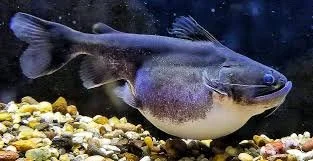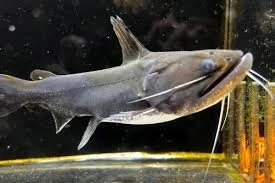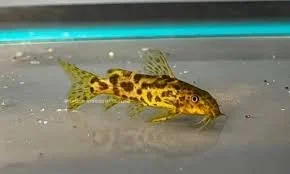 Image 1 of 1
Image 1 of 1


Catfish - Spotted Pictus
Species: Spotted Pictus Catfish (Pimelodus pictus)
Tank Requirements:
Tank Size: Provide a tank with a minimum capacity of 30 gallons for a small group of Spotted Pictus Catfish. They can grow up to 5-6 inches in size and require ample swimming space.
Water Temperature: Maintain a temperature between 75-80°F (24-27°C).
Water Parameters: Aim for a pH level of 6.5-7.5 and a hardness of 5-15 dGH.
Filtration: Install a reliable filtration system to maintain water quality and provide moderate water movement.
Substrate and Decor: Use a soft substrate like sand or fine gravel. Provide hiding spots using caves, driftwood, and rocks. The addition of plants (live or artificial) can also create a more natural environment.
Feeding:
Diet: Spotted Pictus Catfish are omnivorous, but they primarily feed on meaty foods. Offer them a varied diet that includes high-quality sinking pellets or tablets as the staple. Supplement their diet with live or frozen foods such as bloodworms, brine shrimp, daphnia, and small insect larvae.
Feeding Frequency: Feed Spotted Pictus Catfish small amounts once or twice a day, providing what they can consume within a few minutes. Adjust the quantity based on their appetite and avoid overfeeding.
Tankmates:
Compatibility: Spotted Pictus Catfish are generally peaceful and can be kept with other peaceful community fish species.
Suitable Tankmates: Good tankmates include other medium-sized peaceful fish such as tetras, rasboras, gouramis, and peaceful bottom dwellers like corydoras catfish and small loaches.
Maintenance:
Water Changes: Perform regular partial water changes of 25-30% every 1-2 weeks to maintain water quality and remove accumulated toxins.
Water Testing: Regularly test water parameters, including ammonia, nitrite, nitrate, pH, and temperature, to ensure they remain within the appropriate range.
Cleaning: Routinely clean the tank by removing any excess waste, debris, and decaying plant matter. Regularly clean the filter to prevent clogging and ensure efficient water circulation.
Behavior and Health:
Behavior: Spotted Pictus Catfish are active and social fish. They are known for their attractive spotted patterns and elongated body shape. They are primarily bottom-dwellers but may swim throughout the aquarium.
Signs of Good Health: Look for active swimming, vibrant colors, intact fins, and a healthy appetite. Any signs of illness, such as lethargy, loss of color, clamped fins, or abnormal growths, should be promptly addressed.
Remember to monitor your Spotted Pictus Catfish regularly, maintain good water quality, and provide a well-balanced diet to ensure their overall health and well-being.
Species: Spotted Pictus Catfish (Pimelodus pictus)
Tank Requirements:
Tank Size: Provide a tank with a minimum capacity of 30 gallons for a small group of Spotted Pictus Catfish. They can grow up to 5-6 inches in size and require ample swimming space.
Water Temperature: Maintain a temperature between 75-80°F (24-27°C).
Water Parameters: Aim for a pH level of 6.5-7.5 and a hardness of 5-15 dGH.
Filtration: Install a reliable filtration system to maintain water quality and provide moderate water movement.
Substrate and Decor: Use a soft substrate like sand or fine gravel. Provide hiding spots using caves, driftwood, and rocks. The addition of plants (live or artificial) can also create a more natural environment.
Feeding:
Diet: Spotted Pictus Catfish are omnivorous, but they primarily feed on meaty foods. Offer them a varied diet that includes high-quality sinking pellets or tablets as the staple. Supplement their diet with live or frozen foods such as bloodworms, brine shrimp, daphnia, and small insect larvae.
Feeding Frequency: Feed Spotted Pictus Catfish small amounts once or twice a day, providing what they can consume within a few minutes. Adjust the quantity based on their appetite and avoid overfeeding.
Tankmates:
Compatibility: Spotted Pictus Catfish are generally peaceful and can be kept with other peaceful community fish species.
Suitable Tankmates: Good tankmates include other medium-sized peaceful fish such as tetras, rasboras, gouramis, and peaceful bottom dwellers like corydoras catfish and small loaches.
Maintenance:
Water Changes: Perform regular partial water changes of 25-30% every 1-2 weeks to maintain water quality and remove accumulated toxins.
Water Testing: Regularly test water parameters, including ammonia, nitrite, nitrate, pH, and temperature, to ensure they remain within the appropriate range.
Cleaning: Routinely clean the tank by removing any excess waste, debris, and decaying plant matter. Regularly clean the filter to prevent clogging and ensure efficient water circulation.
Behavior and Health:
Behavior: Spotted Pictus Catfish are active and social fish. They are known for their attractive spotted patterns and elongated body shape. They are primarily bottom-dwellers but may swim throughout the aquarium.
Signs of Good Health: Look for active swimming, vibrant colors, intact fins, and a healthy appetite. Any signs of illness, such as lethargy, loss of color, clamped fins, or abnormal growths, should be promptly addressed.
Remember to monitor your Spotted Pictus Catfish regularly, maintain good water quality, and provide a well-balanced diet to ensure their overall health and well-being.







